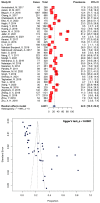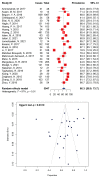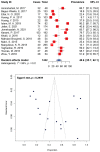Prevalence of Multidrug-Resistant Diarrheagenic Escherichia coli in Asia: A Systematic Review and Meta-Analysis
- PMID: 36289991
- PMCID: PMC9598397
- DOI: 10.3390/antibiotics11101333
Prevalence of Multidrug-Resistant Diarrheagenic Escherichia coli in Asia: A Systematic Review and Meta-Analysis
Abstract
Diarrhea is one of the leading causes of morbidity and mortality in developing countries. Diarrheagenic Escherichia coli (DEC) is an important bacterial agent for diarrhea in infants, children, and international travelers, and accounts for more than 30% of diarrheal cases in children less than 5 years old. However, the choices of antimicrobial agents are now being limited by the ineffectiveness of many first-line drugs, in relation to the emergence of antimicrobial-resistant E. coli strains. The aim of this systematic review and meta-analysis was to provide an updated prevalence of antimicrobial-resistant DEC in Asia. A comprehensive systematic search was conducted on three electronic databases (PubMed, ScienceDirect, and Scopus), where 40 eligible studies published between 2010 and 2022 were identified. Using meta-analysis of proportions and a random-effects model, the pooled prevalence of DEC in Asian diarrheal patients was 22.8% (95% CI: 16.5-29.2). The overall prevalence of multidrug-resistant (MDR) and extended-spectrum beta-lactamase (ESBL)-producing DEC strains was estimated to be 66.3% (95% CI: 58.9-73.7) and 48.6% (95% CI: 35.1-62.1), respectively. Considering antimicrobial drugs for DEC, the resistance prevalence was highest for the penicillin class of antibiotics, where 80.9% of the DEC isolates were resistant to amoxicillin and 73.5% were resistant to ampicillin. In contrast, resistance to carbapenems such as imipenem (0.1%), ertapenem (2.6%), and meropenem (7.9%) was the lowest. The relatively high prevalence estimation signifies that the multidrug-resistant DEC is a public health threat. Effective antibiotic treatment strategies, which may lead to better outcomes for the control of E. coli infections in Asia, are necessary.
Keywords: Asia; Escherichia coli; antibiotic resistance; diarrheagenic; epidemiology; meta-analysis; systematic review.
Conflict of interest statement
The authors declare no conflict of interest.
Figures





Similar articles
-
Prevalence of Multidrug-Resistant and Extended-Spectrum Beta-Lactamase-Producing Shigella Species in Asia: A Systematic Review and Meta-Analysis.Antibiotics (Basel). 2022 Nov 18;11(11):1653. doi: 10.3390/antibiotics11111653. Antibiotics (Basel). 2022. PMID: 36421297 Free PMC article. Review.
-
Characteristics of diarrheagenic Escherichia coli among children under 5 years of age with acute diarrhea: a hospital based study.BMC Infect Dis. 2018 Feb 1;18(1):63. doi: 10.1186/s12879-017-2936-1. BMC Infect Dis. 2018. PMID: 29390982 Free PMC article.
-
Antibiotic resistance and molecular characterization of diarrheagenic Escherichia coli and non-typhoidal Salmonella strains isolated from infections in Southwest China.Infect Dis Poverty. 2018 May 7;7(1):53. doi: 10.1186/s40249-018-0427-2. Infect Dis Poverty. 2018. PMID: 29792233 Free PMC article.
-
Molecular Epidemiology of Extended-Spectrum β-Lactamase-Producing Escherichia coli Pathotypes in Diarrheal Children from Low Socioeconomic Status Communities in Bihar, India: Emergence of the CTX-M Type.Infect Dis (Auckl). 2017 Nov 6;10:1178633617739018. doi: 10.1177/1178633617739018. eCollection 2017. Infect Dis (Auckl). 2017. PMID: 29151781 Free PMC article.
-
Extended-spectrum beta-lactamase-producing strains among diarrhoeagenic Escherichia coli-prospective traveller study with literature review.J Travel Med. 2022 Jan 17;29(1):taab042. doi: 10.1093/jtm/taab042. J Travel Med. 2022. PMID: 33834207 Free PMC article. Review.
Cited by
-
Prevalence of Multidrug-Resistant and Extended-Spectrum Beta-Lactamase-Producing Shigella Species in Asia: A Systematic Review and Meta-Analysis.Antibiotics (Basel). 2022 Nov 18;11(11):1653. doi: 10.3390/antibiotics11111653. Antibiotics (Basel). 2022. PMID: 36421297 Free PMC article. Review.
-
Prevalence of common diarrheagenic enterobacteriaceae in Iran (2000-2023): a systematic review and meta-analysis.BMC Gastroenterol. 2025 Jan 29;25(1):43. doi: 10.1186/s12876-025-03634-3. BMC Gastroenterol. 2025. PMID: 39881226 Free PMC article.
-
Characteristics of antimicrobial peptide OaBac5mini and its bactericidal mechanism against Escherichia coli.Front Vet Sci. 2023 Feb 23;10:1123054. doi: 10.3389/fvets.2023.1123054. eCollection 2023. Front Vet Sci. 2023. PMID: 36908510 Free PMC article.
-
Anti-Inflammatory and Antimicrobial Effects of Herbal Formulation Called Apo-Taat Using Extended-Spectrum ß-Lactamase-Producing Escherichia coli Isolates.ScientificWorldJournal. 2025 Feb 3;2025:6151640. doi: 10.1155/tswj/6151640. eCollection 2025. ScientificWorldJournal. 2025. PMID: 39949663 Free PMC article.
-
Genomic features of three major diarrhoeagenic Escherichia coli pathotypes in India.Microb Genom. 2025 Jul;11(7):001430. doi: 10.1099/mgen.0.001430. Microb Genom. 2025. PMID: 40622118 Free PMC article.
References
-
- Pickering L.K. Feigin and Cherry’s Textbook of Pediatric Infectious Diseases. Elsevier; Amsterdam, The Netherlands: 2009. Approach to patients with gastrointestinal tract infections and food poisoning; pp. 621–653. - DOI
Publication types
Grants and funding
LinkOut - more resources
Full Text Sources
Research Materials

